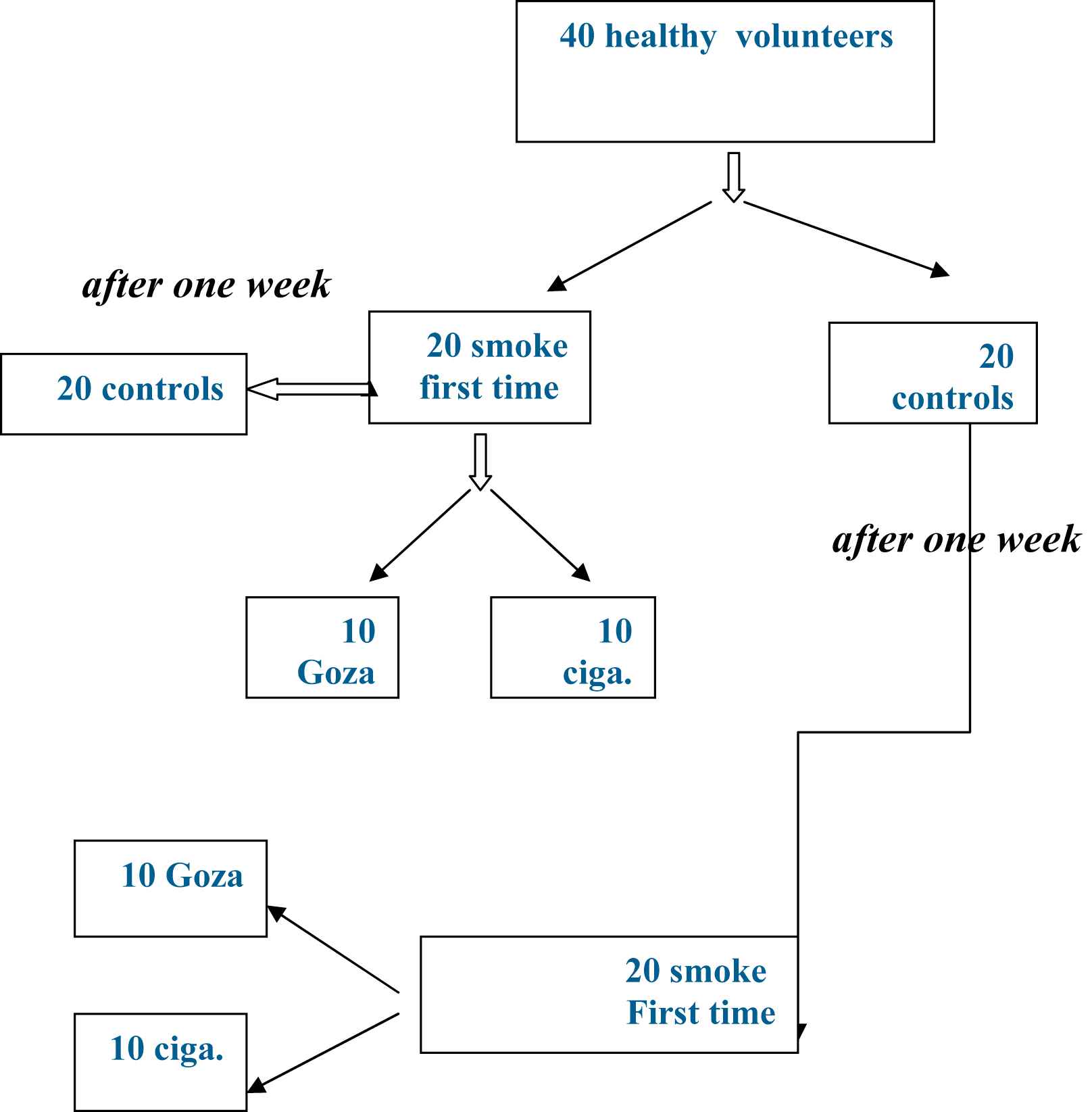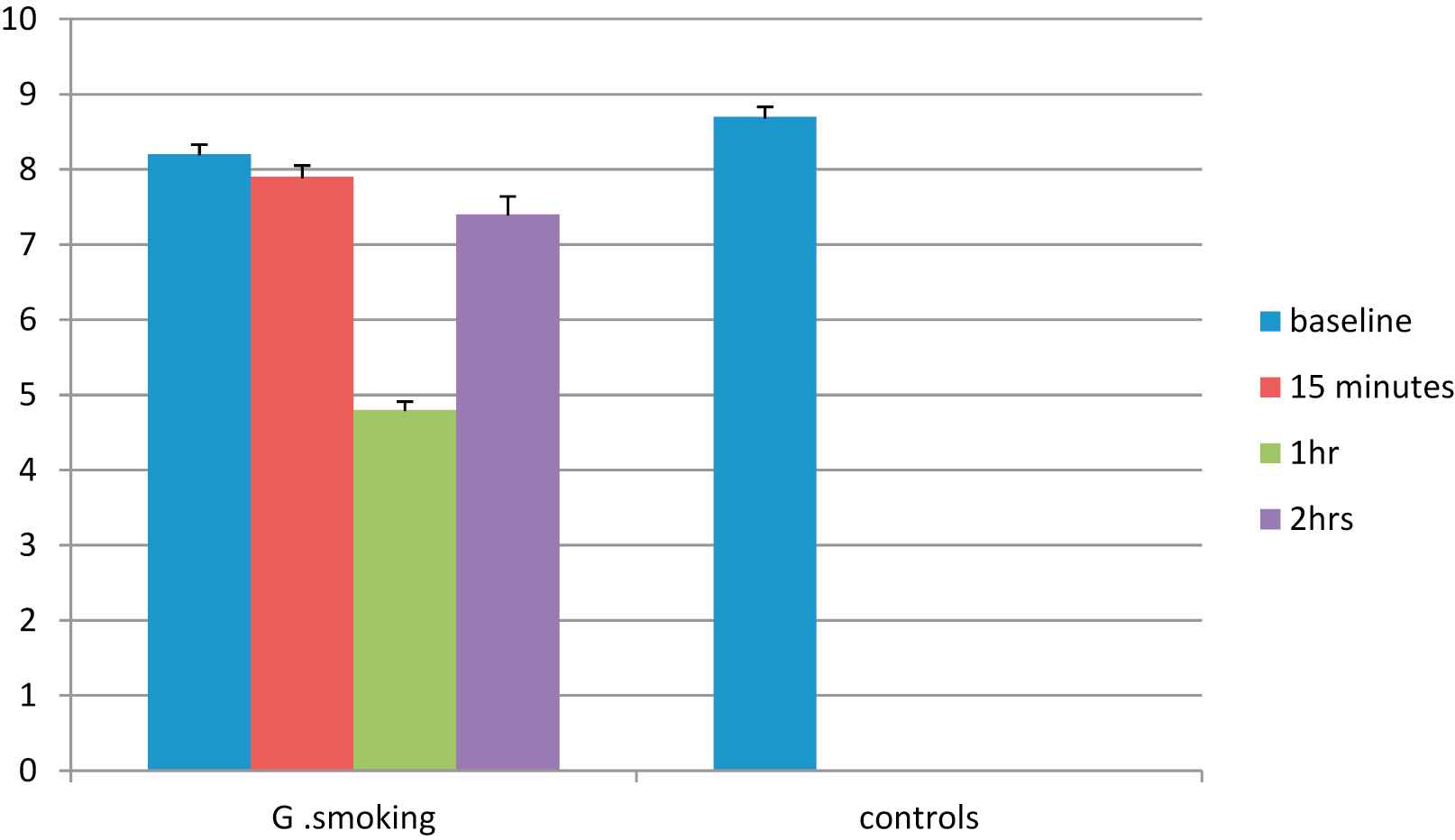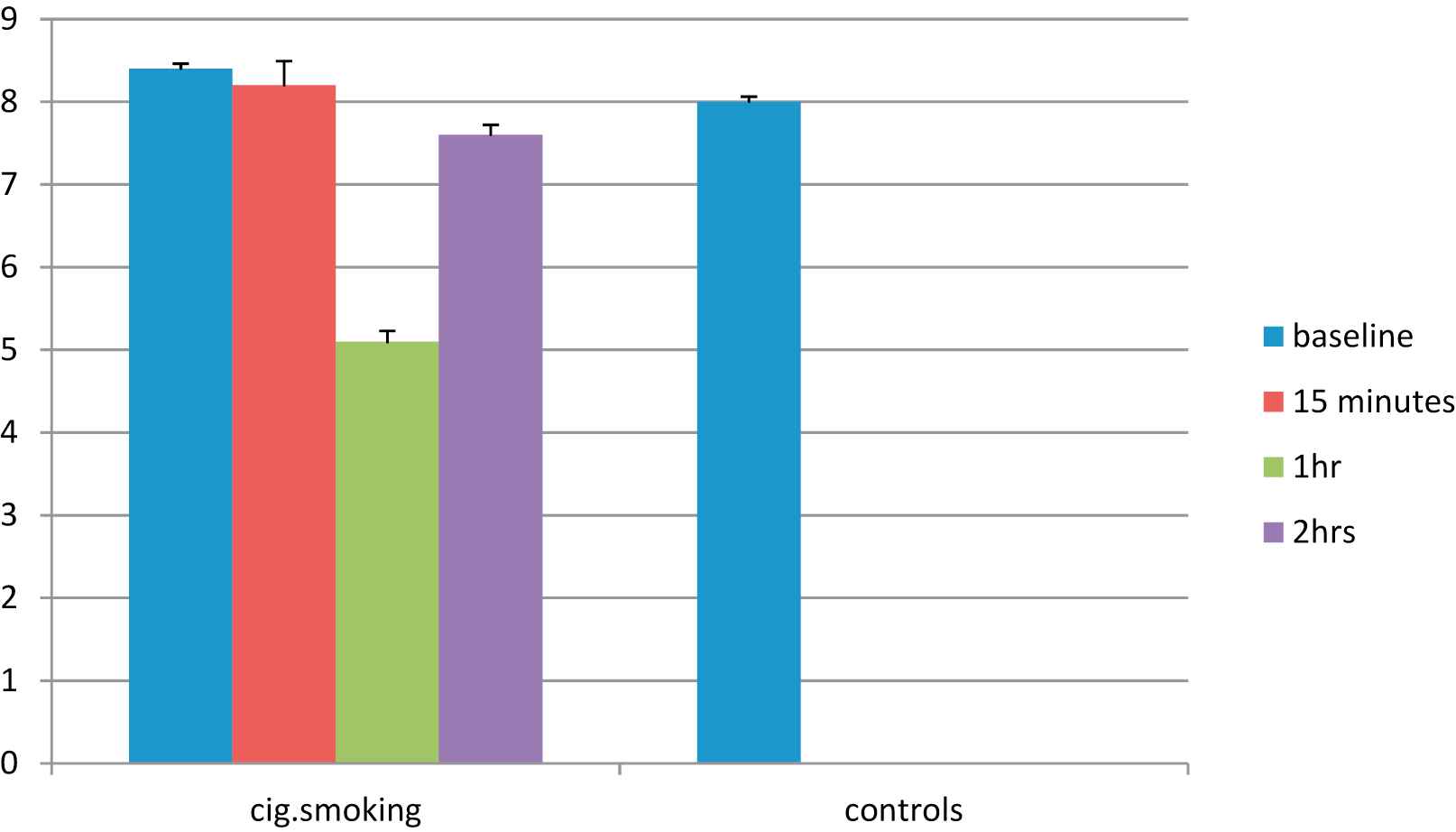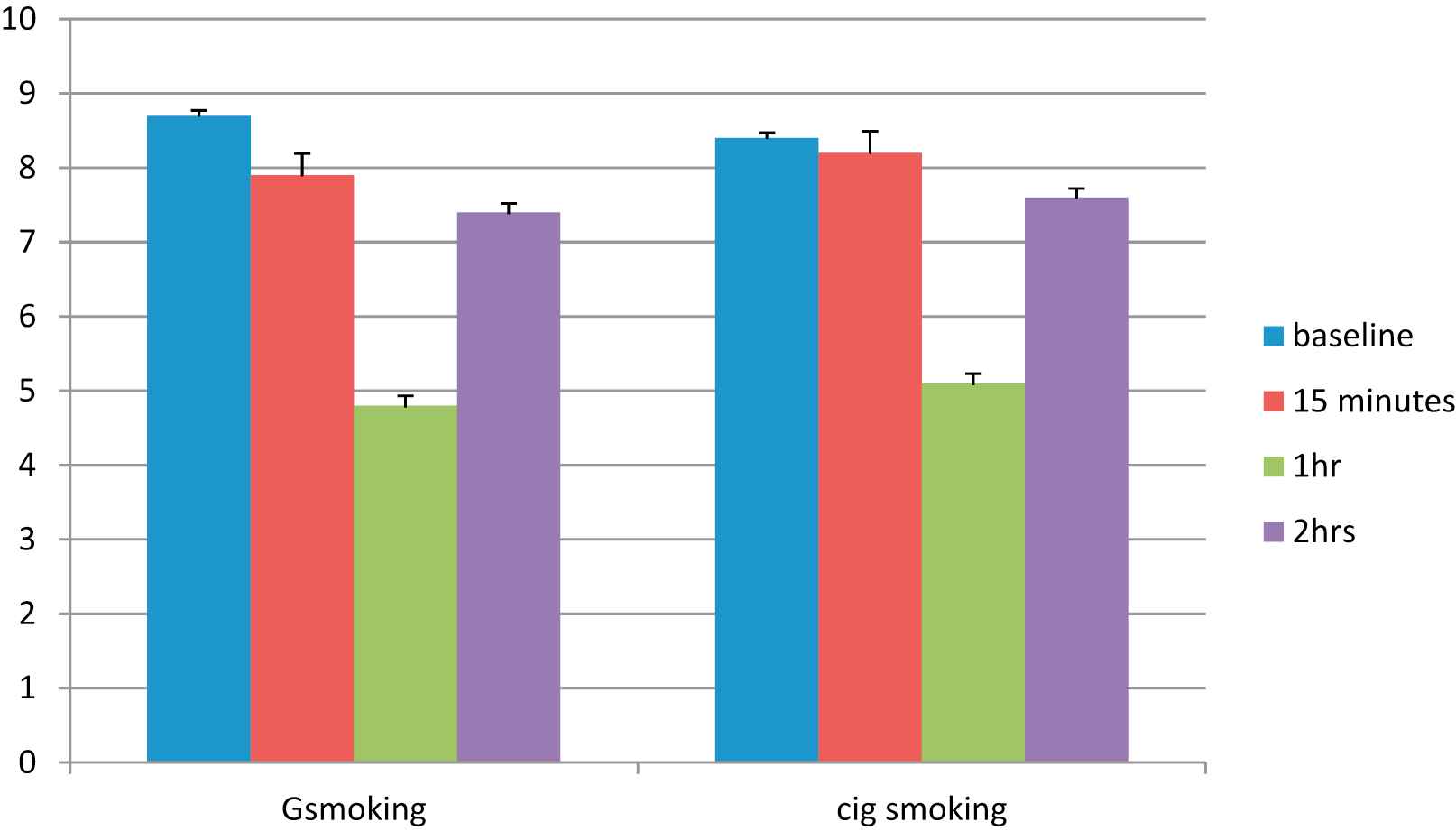The effects of pipe water smoking on endothelial function in healthy non smoker volunteers
- DOI
- 10.1016/j.artres.2016.05.001How to use a DOI?
- Keywords
- Pipe water smoking; Endothelial dysfunction; FMD%
- Abstract
Background: Water pipe (WP) tobacco smoking is gaining wide popularity among young and middle aged males and females.
Aim of the work: The aim of this study was to evaluate the immediate effect of 1st pipe water smoking on brachial Flow mediated dilatation% (FMD%) and Nitrate mediated dilatation% (NMD%) as markers of systemic endothelial function.
Methods: The present study comprised of 40 young healthy volunteers with no cardiovascular risk factors (the mean age 28 ± 5 years, males) randomized to either smoking (cigarette or pipe water) or not smoking in a crossover fashion. All the participants underwent a physical examination, laboratory analysis, Standard echocardiography, brachial artery FMD% = [(Dmax–Dbase)/Dbase] multiplied by 100 (%). and endothelium independent dilation (NMD%) = [(DNTG-Dbase)/Dbase] multiplied by 100 (%) were assessed with a high-resolution ultrasound probe and the arterial diameters before smoking, just after smoking, 1 h and 2 h after obtained.
Results: FMD% after 1 h of both water pipe and cigarette were significantly lower (p < 0.001) than FMD% of the base – line and normalized after 2 h. No differences in median NMD % values (p > 0.05).
Conclusion: Our findings confirm that even one time pipe water smoking is associated with systemic endothelial dysfunction comparable to cigarette smoking in young non-smoker volunteers with no cardiovascular disorders or risk factors.
- Copyright
- © 2016 Association for Research into Arterial Structure and Physiology. Published by Elsevier B.V. All rights reserved.
- Open Access
- This is an open access article distributed under the CC BY-NC license.
Introduction
Smoking is a major cause of cardiovascular disease mortality.1,2 Current research, treatment, and policy efforts focus on cigarette smoking, while many people in developing regions smoke tobacco using water pipes. Available evidence suggests that WP use is increasing globally.3 Studies on the cardiovascular effects of WP smoking are limited due to the quality of methods, the novelty of WP epidemic relative to cigarettes, and the highly variable WP tobacco contents.
The misconception that water pipe is less harmful than cigarette increases its spread to other segments of society, particularly among young men and women. Water pipes (also known as gouza, narghile, hubble-bubble, hookah, or shisha) are increasing in popularity, and more must be learned about them so that we can understand their effects on public health monitor spread and help users to quit.4
Smoking causes endothelial dysfunction through impairment of nitric oxide (NO) production, or increased oxidative stress by a large number of free radicals existing in smoke.5 Since endothelial dysfunction is a well-documented early phenomenon in atherosclerosis as it precedes structural changes and clinical manifestations, major research efforts have focused on its detection in humans.6
Flow-mediated vasodilation (FMD) of the brachial artery is a noninvasive, validated measure that evaluates endothelial function and predicts future CVD events.7,8 FMD is the most often used method to investigate the systemic endothelial function.7,9,10 This technique relies on brachial artery dilation produced by endothelial release of endogenous vasodilators [principally nitric-oxide (NO)] in response to increased blood flow and shear stress.
Previous studies have shown that chronic pipe water smoking is associated with impaired FMD%.11,12 However, exposure to pipe water smoke has also been shown to have more immediate effects.13 To demonstrate further the effects of pipe water smoking on the vasculature, we investigated the acute effects of active first time pipe water smoking compared to 1st cigarette smoking on the FMD% and NMD of healthy non smoker volunteers.
Study design
After the ethical committee of Tanta university approval, 59 young (28 ± 5 years, males), healthy non-smokers were included. Informed consent taken from all volunteers. All subjects had a normal health declaration. 19 volunteers exhibit nausea, sickness and cannot complete smoking. So only 40 continue the study protocol. 20 subjects smoked outdoors apple flavored pipe water for approximately 30 min and another 20 smoked one cigarette for 5 min. All the subjects were instructed not to eat, drink caffeine or take vitamin C supplements 12 h before the study, and no heavy physical exercise at least 1 day in advance of the study. FMD%, NMD% obtained at baseline, 15 min after, 1 and 2 h after exposure following at least 15 min of rest in a semi-supine position. 20 0f them smoke (10 cigarette, 10 pipe water) and other 20 subjects as controls and the opposite occurs after one week (Fig. 1 ).

Study design.
Exclusion criteria
- 1-
Cardiovascular disease or risk factors.
- 2-
Asthma and or allergy.
- 3-
Respiratory infection within 4 weeks of the study.
Methods
All study groups were subjected to the following assessment:
- 1-
Complete history taking.
- 2-
Clinical evaluation.
- 3-
Routine laboratory investigations:
Complete blood count, urine analysis, kidney function tests and liver function test. Lipid profile which includes: Total cholesterol, Triglyceride, Low-density lipoprotein, high-density lipoprotein.
FMD%, NMD% assessment
FMD%, NMD % were assessed using a high resolution (7.5 MHz) vascular ultrasound probe. Vascular studies were performed by the 2 experienced investigators in a temperature-controlled room between 10 am and 12 am. After resting in supine position for 15 min, their heart rate, blood pressure were measured and baseline arterial image was acquired from the right arm 2–5 cm above the antecubital fossa. When a suitable 2-dimensional longitudinal axis image of the vessel was obtained and digitally recorded, the position of the ultrasound probe was fixed and remained unchanged throughout the examination.
Arterial diameter measurements were performed off-line as a distance between the near and far wall lumen intima boundaries at end-diastole (onset of the R wave on the ECG).
After determination of the baseline arterial diameter (D base) a sphymgo-manometric cuff was placed on the forearm and inflated to 200 mmHg or more for 5 min. Hyperaemia was produced by rapid cuff deflation. Digital recording of the brachial artery was resumed 30 s before and continued for 90 s after cuff deflation.14 Approximately 60 s after cuff deflation brachial artery was measured again to determine the diameter of the maximal endothelium-dependent dilation (Dmax). FMD was calculated using a formula: FMD% = [(Dmax–Dbase)/Dbase] multiplied by 100 (%). Endothelium-independent dilation (NMD%), a measure of vascular smooth muscle vasoreactivity, was assessed 15–20 min after FMD% to allow for the restoration of baseline conditions. Five min after sublingual administration of 0.4 mg of nitroglycerine, brachial artery diameter was measured to determine nitroglycerine-induced dilation (DNTG). NMD% was calculated using a formula: NMD% = [(DNTG−Dbase)/Dbase] multiplied by 100 (%).
Vascular studies were successful in all the participants. Inter- and intra-observer variations in baseline brachial artery measurements in our laboratory are 0.05 ± 0.02 mm and0.03 ± 0.01 mm, respectively.
Statistics
Statistical presentation and analysis of the present study was conducted using the mean, standard deviation and Unpaired t-test used to compare between different parameters.
Results
Demographic and clinical data are summarized in Table 1 .
| Parameters | Values |
|---|---|
| Age | 28 ± 5 |
| Sex | 40 males |
| BMI | 23.2 ± 1.6 |
| Serum cholesterol (mmol/L) | 4.5 ± 0.5 |
| LDL | 1.9 ± 0.6 |
| Triglycerides | 1.1 ± 0.2 |
| HDL | 1.4 + 0.4 |
| Systolic blood pressure | 122 ± 9 |
| Diastolic blood pressure | 75 ± 5 |
| Fasting blood sugar | 4.2 ± 0.8 |
| LVEF% | 61.4 ± 4.5 |
| LVFS% | 32 ± 5 |
Demographic, Clinical, Echo data of study group (40 healthy volunteers).
A vascular study revealed similar median baseline brachial artery diameters in both 1st cigarette or pipe water smokers and the controls (Tables 2 and 3 ). An increase in arterial diameter after cuff deflation was observed in all subjects. Endothelium dependent dilation occurred and measured after 15 min, 1 h, 2 h (Tables 2 and 3). Maximal endothelium-dependent diameter change (Dmax−Dbase) was considerably greater in healthy subjects than after smoking (p less than 0.001) (Tables 2 and 3), Figs. 2 and 3 .

Change of FMD% after 1st Goza smoking from baseline (15 min, 1 h, 2 h) compared to controls.

Change of FMD% after 1st cigarette smoking from baseline (15 min, 1 h, 2 h) compared to controls.
| Parameters | Baseline D | Dmax−Dbase | FMD% | P value |
| 1st Goza smoking | 4.1 + 0.15 | 0.2 + 0.11 | 4.8 ± 0.5 | <0.001 |
| Controls | 3.95 + 0.12 | 0.35 + 0.07 | 8.7 ± 0.6 | S |
| Parameters | Baseline D | Dmax−Dbase | NMD% | P value |
| 1st Goza smoking | 4.11 + 0.13 | 0.45 + 0.12 | 10.6 + 1.4 | 0.14 |
| Controls | 4.0 + 0.14 | 0.47 + 0.08 | 11.3 + 1.6 | NS |
D = diameter, S=Significant P-value < 0.05, N.S.: not significant > 0.05.
Baseline brachial diameter, change in diameter, FMD% after 1 h exposure of 1st Goza smoking.
| Parameters | Baseline D | Dmax−Dbase | FMD% | P value |
| 1st cigarette smoking | 4.3 + 0.14 | 0.24 + 0.14 | 5.1 ± 0.6 | <0.001 |
| Controls | 3.89 + 0.13 | 0.31 + 0.06 | 8.0 ± 0.3 | S |
| Parameters | Baseline D | Dmax−Dbase | NMD% | P value |
| 1st cigarette smoking | 4.21 + 0.12 | 0.47 + 0.13 | 11.1 + 1.2 | 0.17 |
| Controls | 4.1 + 0.13 | 0.46 + 0.07 | 11.7 + 1.5 | NS |
D = diameter, S=Significant P-value < 0.05, N.S.: not significant > 0.05.
Baseline brachial diameter, change in diameter, FMD% after 1 h exposure of 1st cigarette smoking.
On the other hand, arterial dilation was observed in all the subjects after nitroglycerine application, and there was no difference in the absolute diameter change (DNTG-Dbase) or median NMD% value (p > 0.05 for both) as presented in Tables 2 and 3.
There were no significant differences between the 2 groups (water pipe and cigarette smoking) regarding FMD% and NMD % Table 4 , Fig. 4 .

Comparing change of FMD% after 1st Goza and 1st cigarette smoking from baseline (15 min, 1 h, 2 h).
| Parameters | 1st Goza smoking | 1st cigarette smoking | P value |
|---|---|---|---|
| FMD% after 1 h | 4.8 ± 0.5 | 5.1 ± 0.6 | 0.094 |
| NMD% after 1 h | 10.6 + 1.4 | 11.1 ± 1.2 | 0.23 |
S=Significant P-value < 0.05.
FMD% after 1 h 1st Goza and 1st cigarette smoking.
Discussion
Smoking is an important, modifiable risk factor for CVDs and according to WHO data, smoking is responsible for10% of all CVD cases.15 Smoking plays a strong role not only in CVD initiation, but also in disease progression and fatal cardiovascular outcomes. Smoking-induced atherogenesis initiators are endothelial dysfunction and damage, oxidation of proatherogenic lipids, decrease of high-density lipoprotein, induction of inflammation, and the procoagulant state in the circulation.
“Smoking cessation is and will remain the most effective measure to prevent smoking-caused CVDs”.16
In 1993, Celermajer et al.9 showed that smoking reduces flow-mediated dilatation (FMD) in systemic arteries in healthy, young adults. Later on, several experimental studies suggested a link between proatherogenic cellular and molecular effects of cigarette smoke and initiation of CVD. Secondhand smoking also was shown to impair endothelium-dependent arterial dilatation in young subjects, which was shown to be reversible1 year after cessation of exposure.17,18
Cigarette smoking has been recognized to be associated with inflammation and impaired endothelial function,5 but little is known regarding WP smoking.
The present study provides a new insight into the effect of water pipe smoking on the function of the endothelium by evaluation of FMD%, NMD% in healthy, young non-smoker subjects before, 15 min, 1 h and 2 h after smoking. Our results showed that first time outdoor active smoking for 30 min in young healthy non-smoker causes an immediate decrease in FMD% (maximally after 1 h and return to normal 2 h after) compared to controls and also there were no significant differences between the 2 groups (water pipe and cigarette smoking) regarding FMD% and NMD %. To our knowledge the uniqueness in the present study that it is the first one measured, reliable simple parameter of endothelial damage after 1st pipe water smoking and confirm acute reversible endothelial injury.
Previous studies11,12 investigated the effect of long term pipe water smoking on endothelial function compared to cigarettes, using brachial artery Doppler ultrasound in asymptomatic young adults with no other cardiovascular risk factors compared with healthy, non-smokers, age matched subjects with no cardiovascular risk factors. FMD% was significantly impaired among pipe smokers compared to cigarette smokers and non-smokers. They concluded that WP smokers and cigarette smokers had comparable degrees of inflammation and endothelial dysfunction.
The issue of 1st smoking acute endothelial injury wasn’t previously studied except in very few studies and to our knowledge, no studies done on 1st time pipe water smoking, Fariborz Mobarrez19 et al. enrolled 12 healthy subjects with interment light smoking and the effect of one cigarette smoking on the function of the endothelium was evaluated. Their results demonstrated that active smoking of one cigarette causes an immediate increase in the number of circulating EPCs as well as MPs. They concluded that smoking of just one single cigarette for a short period of time can cause MP-release as well as EPCs mobilization suggesting immediate systemic events that can impact on vascular integrity and could promote events important in atherosclerosis. In fariborz study, subjects were intermittent cigarette smokers not non-smoker at all experienced pipe water or cigarette smoking for the first time as in our study and also our study depends upon reliable, simple parameter documented long –time ago as endothelial dysfunction marker. Moreover, Papamichael MC20 evaluated endothelial function in seventeen healthy individuals by FMD% of the brachial artery, before, immediately after and 30, 60 and 90 min after smoking a regular cigarette or the corresponding ‘light’ cigarette. FMD was significantly depressed after smoking both types immediately after smoking and it remained significantly depressed in the regular cigarette group at 30 min and 60 min.
Study limitations
- -
small group number
- -
All the study group were males as females refused the test, so sex different response was not estimated. Large number studies, including both sexes are recommended.
Conclusion
Our findings confirm that even one active pipe water smoking is associated with systemic endothelial dysfunction comparable to 1st cigarette smoking confirmed by an immediate decrease in FMD% in young non-smoker volunteers with no cardiovascular disorders or risk factors.
Conflict of interests
None.
Abbreviations
- WP
water pipe
- FMD%
flow mediated dilatation%
- NMD%
nitrate mediated dilatation
- Dmax
maximum diameter measure 60 s after deflation
- Dbase
baseline diameter before inflation or sublingual nitroglycerine
- NTG base
diameter 5 min after sublingual nitroglycerine
References
Cite this article
TY - JOUR AU - Rania Gaber AU - Manal Hamesa PY - 2016 DA - 2016/05/26 TI - The effects of pipe water smoking on endothelial function in healthy non smoker volunteers JO - Artery Research SP - 1 EP - 5 VL - 15 IS - C SN - 1876-4401 UR - https://doi.org/10.1016/j.artres.2016.05.001 DO - 10.1016/j.artres.2016.05.001 ID - Gaber2016 ER -
